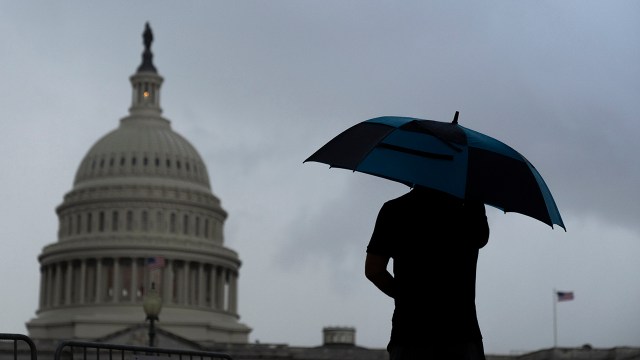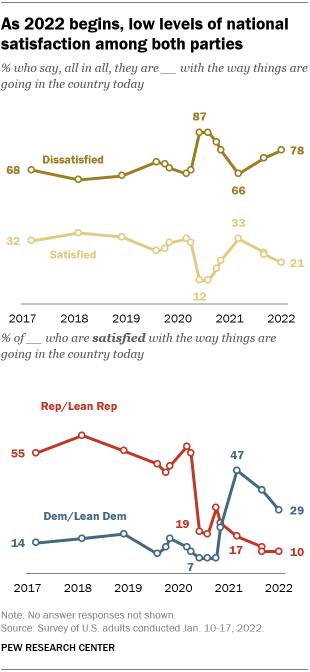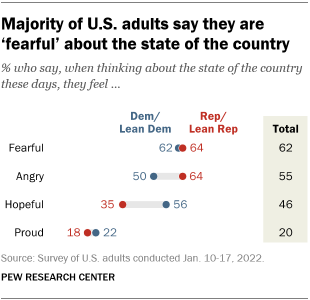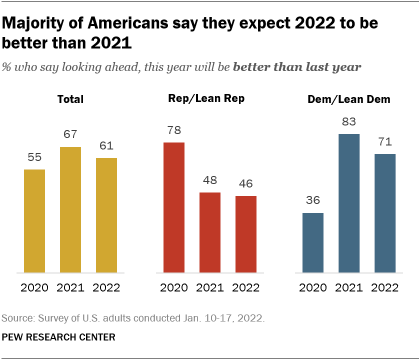
Facing successive waves of the coronavirus and an uncertain economy, the public enters 2022 largely dissatisfied about the way things are going in the United States and fearful about the state of the nation.
However, a majority of U.S. adults (61%) are optimistic that the new year will be better than the year that just ended, according to a new survey from Pew Research Center.
Public satisfaction with national conditions remains low. Just 21% say they are satisfied with the way things are going in the country, while 78% are dissatisfied. The share expressing satisfaction with the state of the nation is down slightly since September (26%) and down 12 percentage points since last March (from 33%). The new survey also finds that the public’s views of the national economy remain mostly negative and that majorities continue to view the coronavirus as a major threat to the economy and public health.
Today, only small shares of both Democrats and Republicans (and those who lean to each party) say they are satisfied with the way things are going – though Democrats are nearly three times as likely as Republicans to have a positive view (29% vs. 10%).
For most of Donald Trump’s presidency, majorities of Republicans were satisfied with national conditions, compared with fewer than a quarter of Democrats. But by the summer of 2020, amid the spread of the coronavirus and criminal justice protests, members of both parties were largely negative toward national conditions.
To assess the mood of Americans as a new year begins, we surveyed 5,128 U.S. adults during the period of Jan. 10-17, 2022. Everyone who took part is a member of Pew Research Center’s American Trends Panel (ATP), an online survey panel that is recruited through national, random sampling of residential addresses. This way nearly all U.S. adults have a chance of selection. The survey is weighted to be representative of the U.S. adult population by gender, race, ethnicity, partisan affiliation, education and other categories. Read more about the ATP’s methodology.
Here are the questions used for the report, along with responses, and its methodology.
Today, Democrats are far less satisfied with the way things are going than they were last March (47% then vs. 29% today). Republicans’ already-low level of satisfaction also declined from 17% to 10%.
Americans continue to express negative rather than positive emotions when thinking about national conditions these days.
Majorities say they feel “fearful” (62%) and “angry” (55%) when thinking about the state of the country. Fewer than half feel “hopeful,” while just 20% say they feel “proud.” These views are largely unchanged since November 2020, shortly after the presidential election, though the share of adults who say they feel hopeful has declined (54% then vs. 46% today).
Nearly identical majorities in both parties say they feel fearful about the state of the country, though Republicans are more likely than Democrats to say they feel angry, and much less likely to say they feel hopeful.
While Americans are dissatisfied with current national conditions, a 61% majority say they expect 2022 will be better than 2021. About four-in-ten say they expect that 2022 will be worse.
Democrats are considerably more likely than Republicans to say the coming year will be better (71% vs. 46%, respectively), though optimism among this group has declined slightly since last year.
In January 2020, when Trump was still in office, the reverse was true. Republicans were far more likely to express optimism about the coming year than Democrats (78% vs. 36%).
Note: Here are the questions used for the report, along with responses, and its methodology.


